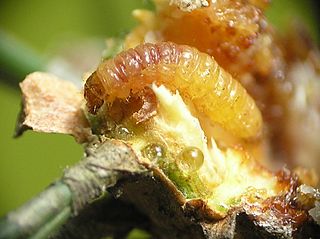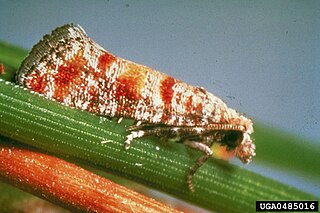
Rhyacionia buoliana, the pine shoot moth, is a moth of the family Tortricidae. It is native to North Africa, North Asia, and Europe, and invasive in North America and South America.

The Zeiraphera griseana, the larch tortrix, is a moth of the family Tortricidae.

Rhyacionia is a genus of moths belonging to the subfamily Olethreutinae of the family Tortricidae.

Gravitarmata margarotana, the pine cone tortrix or pine twig moth, is a moth of the family Tortricidae. In Europe, it is found from England to Austria and Poland, east to the Baltic region to Russia, China, Korea and Japan.

Retinia resinella, the pine resin-gall moth, is a moth of the family Tortricidae.
Epinotia rubiginosana is a moth of the family Tortricidae. It is found from Europe to eastern Russia, China, Korea and Japan.

Retinia cristata is a moth of the family Tortricidae. It is found in Japan, Korea, northern and central China, Taiwan and Thailand.

Rhyacionia duplana, the summer shoot moth or Elgin shoot moth when referring to subspecies logaea, is a moth of the family Tortricidae. It is found from northern and central Europe to eastern Russia, China and Japan. It has also been reported from Korea, but it has not been found in recent studies.

Rhyacionia pinicolana is a moth of the family Tortricidae. It is found from northern and central Europe to eastern Russia, China, Japan and Korea.

Rhyacionia pinivorana, the spotted shoot moth, is a moth of the family Tortricidae. It is found from northern and central Europe to eastern Russia, China, Korea and Japan.

Rhyacionia frustrana, the Nantucket pine tip moth, is a moth of the family Tortricidae. It is found in the United States from Massachusetts south to Florida, west to Missouri, Oklahoma, Texas and California. It is also found in the Dominican Republic, Cuba, Jamaica, Mexico (Oaxaca), Guatemala, Honduras and Nicaragua.

Rhyacionia bushnelli, the western pine tip moth, is a moth of the family Tortricidae. It is found in the United States, including Alabama, Nebraska, North Dakota and Montana.

Rhyacionia subtropica, the subtropical pine tip moth, is a species of moth of the family Tortricidae. It is found in the United States in southern Alabama and Florida. It has also been recorded from Cuba and Belize.

Rhyacionia hafneri is a species of moth of the family Tortricidae. It is found in the Czech Republic, Hungary, Croatia, Bulgaria and Slovenia.
Retinia coeruleostriana is a species of moth of the family Tortricidae. It is found in China, Japan and Russia.
Rhyacionia dolichotubula is a species of moth of the family Tortricidae. It is found in Yunnan, China.
Rhyacionia washiyai is a species of moth of the family Tortricidae. It is found in Japan on the island of Hokkaido.
Rhyacionia insulariana is a species of moth of the family Tortricidae. It is found in China.
Rhyacionia leptotubula is a species of moth of the family Tortricidae. It is found in Heilongjiang and Yunnan in China.

Rhyacionia logaea, the Elgin shoot moth, is a species of moth belonging to the family Tortricidae, and used to be considered a subspecies of Rhyacionia duplana, the summer shoot moth, but is currently recognized as its own species. It has two similar sister species, which are Rhyacionia duplana duplana and Rhyciaonia duplana simulata. Its discovery is attributed to English entomologist John Hartley Durrant, F.E.S., who contributed his findings of the species R. logaea and R. duplana to the Trustees of the British Museum in 1911. The Elgin shoot moth is considered to be a micro-moth.












